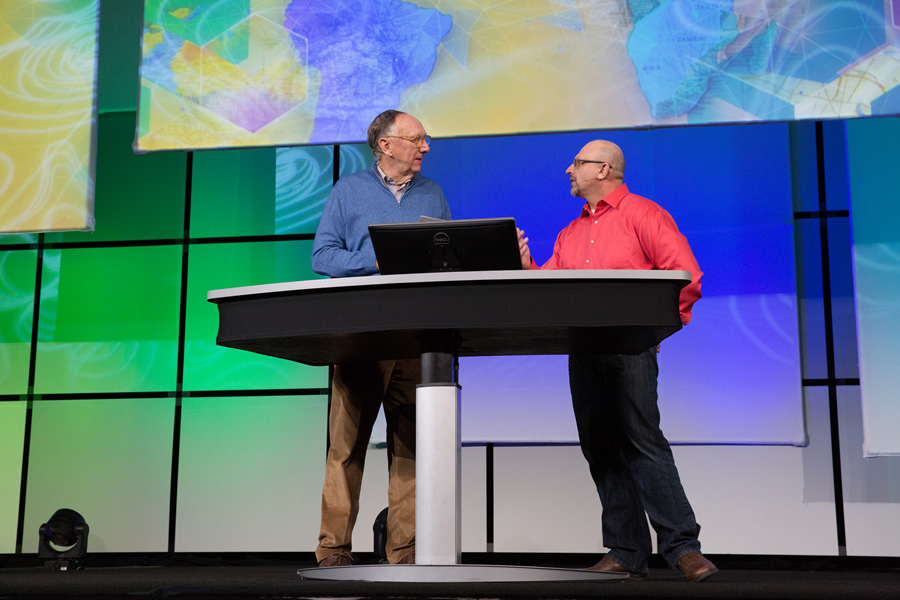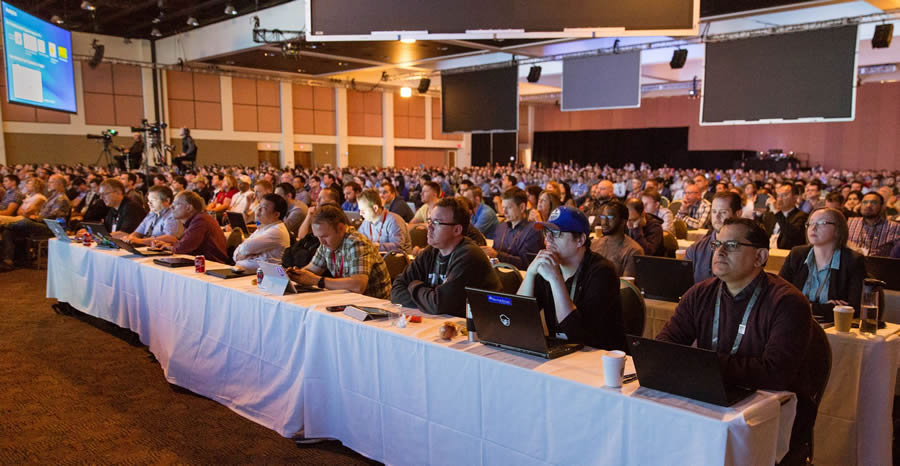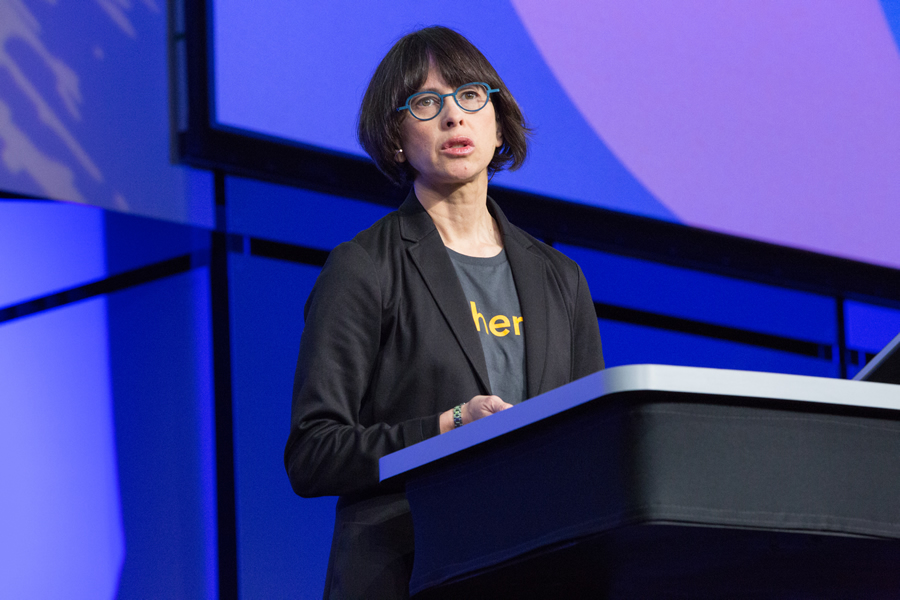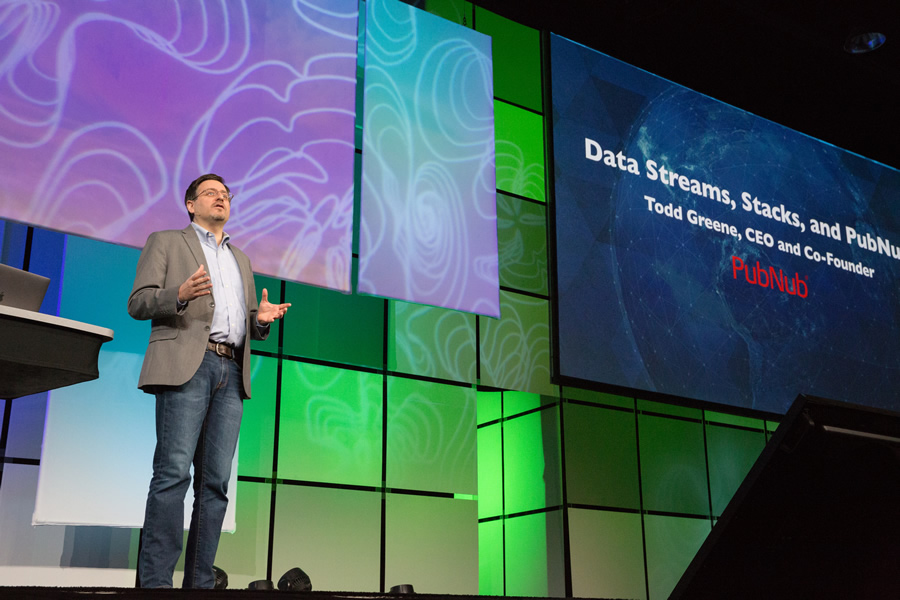
Developers and partners play a highly important role in the ecosystem of geospatial app development for Esri. They take Esri technology, customize it, and create apps for colleagues and customers, all the while offering Esri feedback. These apps are used in many ways: to help companies plan and manage fiber-optic networks, give utilities the ability to track power outages, and help scientists monitor climate change. If there’s a job to do or an analysis to conduct with a location component, there’s likely an app for it.
In opening the 2017 Esri Developer Summit(DevSummit), Jim McKinney from Esri underscored developers’ and partners’ significance to Esri’s mission. “You, as developers and as partners, do make the maps and apps that run our world,” McKinney, chief technology officer for desktop software development at Esri, told the audience of 1,800 people during the Plenary Session.
Over four days in March, attendees feasted on information in tech sessions devoted to the technology that Esri has developed or leverages to power developers’ apps: ArcGIS Runtime SDKs, ArcGIS API for JavaScript, ArcGIS Enterprise, ArcGIS API for Python, Python and R, Calcite maps, Esri CityEngine, ArcGIS GeoAnalytics Server, ArcGIS GeoEvent Server, Insights for ArcGIS, and Web AppBuilder for ArcGIS.
People also attended packed sessions and demo theaters to learn about topics such as emerging technology for indoor routing and tracking, big data and real-time analytics, feature data extraction from imagery, and map pop-up customization using Cascading Style Sheets (CSS) and JavaScript.
Andrea Hemphill, system administrator for Riverside County Fire Department in California, goes to the DevSummit every year to find out where Esri technology is heading. The event is always a learning experience. “It inspires innovation and to think outside the box,” Hemphill said.

The Science of Where
At the root of such innovation and outside-the-box thinking is what Esri president Jack Dangermond calls “The Science of Where.”
“It’s the science of geography and the tech of GIS brought together,” Dangermond said in his welcome remarks to the DevSummit audience.
For developers who use the ArcGIS platform, melding geographic science and GIS technology to produce apps can be powerful: “The Science of Where transforms the world by unlocking the full potential of data within organizations everywhere,” Dangermond said.
Tom Counts’ company, 3-GIS, is an Esri partner that taps into The Science of Where when using Esri technology to develop GIS solutions that help plan, design, and manage fiber-optic networks.
Counts said municipalities that invest in fiber-optic networks need to analyze data to find out where it makes the most financial sense to lay the initial fiber optic cable to get the best return on investment.
“They still want to cover all of their constituents, but if we can give them a build order—and I think Insights for ArcGIS and ArcGIS GeoAnalytics Server can help us do that—[it will] start returning value on that big capital expenditure they are going to [make],” Counts said. “It’s The Science of Where, absolutely.”
The tech sessions led by Esri staff were popular with many attendees. Counts, the chief executive officer (CEO) of 3-GIS, and his developers were devouring as much information from the presentations as possible.
“What’s got me kind of jazzed [is] Insights for ArcGIS [with] the ability to allow our customers to get more value out of their data,” Counts said. He’s also excited about ArcGIS GeoAnalytics Server and the powerful new analytical tools to make sense of big data. “I’ve got a bunch of guys in [a session] now, absorbing as much about GeoAnalytics Server as possible,” Counts said.

For Developers, By Developers
The summit’s theme is always For Developers, By Developers. The technical sessions and product showcase are built around that mantra. So is the Plenary Session, where Esri staff take the stage to talk, developer to developer.
This year, Esri director of software development Sud Menon kicked off the series of presentations and demos with a brief, high-level overview of the ArcGIS platform, a system for managing and applying geographic information.
“Users are working with information and using applications that connect to the platform,” Menon said. “The platform provides identity, an information model that’s made up of maps and scenes, layers, analytics, dashboards, and story maps as well as other information products.”
The platform is powered by services, Menon said. “Those services expose and work with data,” he said. “This makes this platform truly distributed. You can implement it on-premises or in your chosen cloud.”
Menon also called the new ArcGIS Enterprise 10.5, which includes ArcGIS Server, Portal for ArcGIS, and ArcGIS Data Store, “a really big release.”
“It’s a complete GIS in your own infrastructure, and it includes all the familiar components that you’d expect,” he said. “It’s got the portal, GIS servers, and data stores.” But many new capabilities were added, such as the specialized servers, ArcGIS Image Server, ArcGIS GeoEvent Server, ArcGIS GeoAnalytics Server, and ArcGIS Business Analyst Server. “[The servers have] become more decoupled and more focused on their purposes,” Menon said.
ArcGIS Enterprise 10.5 also supports portal-to-portal collaboration, according to Menon. Enterprise systems in each department can share live content through a central enterprise wide portal using item replication. For example, within a large organization, departments such as operations, engineering, planning, and customer service could share information with each other.

Menon’s presentation on ArcGIS Online included some eye-popping statistics: 3.8 million current users, 1 billion map views per day, and 18.8 million open data downloads. “ArcGIS Online is ArcGIS available [as] software as a service. It’s very popular,” he said. “You are making amazing use of it.”
Esri partner GEO Jobe, for example, developed Admin Tools for ArcGIS Online to help administrators of ArcGIS Online organizations perform some tasks faster. App developer Jamie Thompson from GEO Jobe, who works on the suite of no-cost tools, attended her first DevSummit this year and found it to be an excellent learning and networking opportunity.
Besides enjoying sessions on deep learning and graphics processing units (GPUs), indoor mapping, and ArcGIS API for JavaScript, Thompson said she was happy to finally meet in person an Esri employee who has been sending her email with feedback on Admin Tools for ArcGIS Online.
“It was cool,” Thompson said of her meeting.
Building Native Apps
For native app developers, Euan Cameron, Esri’s chief technology officer of developer technologies, shared some good news: there will be two updates this year to the ArcGIS Runtime SDKs release. One of the updates, scheduled for November, will be for stand-alone apps, Cameron said. “It’s to support building apps that are completely stand-alone from the platform—completely disconnected,” he said. “Developers currently using ArcGIS Engine or MapObjects to build their apps will be able to move to ArcGIS Runtime. Their apps will benefit from superior performance and they can target all the modern mobile devices.”
Cameron also introduced the new open-source ArcGIS Runtime Example apps, built with ArcGIS Runtime, that focus on real-world scenarios. “They will help you get started with your next Runtime application,” he said. Example apps are available on GitHub.

Sandie Peters, from Esri’s Android Runtime team, demonstrated an Example app for indoor mapping. Using the mobile Example app with an indoor map of Esri headquarters, she located her office and created a route from there to the site of an on-campus meeting. The app even calculated the time it would take for Peters to walk from her office to the conference room.
“Tapping on a route button, I see it’s a three-minute walk,” she said. (Read more about Example apps in this blog.)
Robert “Bert” Meier enjoys seeing what’s new from Esri each year. As an app developer and employee-owner at Bartlett & West, an engineering and technology company headquartered in Topeka, Kansas, Meier is always on the lookout for timesaving technology. He does a lot of work for railway companies, creating complex mapping applications for managing railroad infrastructure and property.
Meier believes he has found a time-saver in AppStudio for ArcGIS. He arrived in Palm Springs before the official start of the DevSummit to take the presummit hands-on training session Build Native Apps Using AppStudio for ArcGIS.
AppStudio for ArcGIS gives developers the ability to write code once and create mobile apps for iOS, Android, Windows, Mac OS X, and Linux devices, rather than having to rewrite the code for each additional, separate environment.
“This lets you write it once [for] all those different platforms,” Meier said. “It’s going to be a big time-saver. It’s huge. AppStudio is great.”
Attending the Esri DevSummit is important for Meier because he wants to keep up with what’s happening in the ArcGIS world and with technology overall. There’s a lot to know, and that makes Meier’s job challenging.
“It’s harder in the respect that there is so much to know [now] as a developer,” said Meier, who began using Esri technology in 1992. “The breadth of what you need to know or can know is so wide. And things change so fast that you have to be willing to change with it, or [you’ll] get left behind. If you realize that and embrace it, you shouldn’t have a problem.”

Data Streams
Things also are changing fast in the world of live data streaming. Todd Greene, a cofounder and CEO of PubNub, gave developers a taste of what’s new and what’s coming next for data streaming during his DevSummit keynote speech.
His company provides customers with a real-time data stream network in the cloud as well as APIs for developers who are creating mobile, web, and Internet of Things (IoT) applications. In addition, the company also offers real time-analytics, presence, and secure access control.
Greene said he started working full-time at PubNub about six years ago, forgoing a chance to work with a major Hollywood executive. “I had this opportunity to take this little company I had on the side, called PubNub, and grow that,” Greene said. “The reason I came here full-time has been because I feel like we are going through another big revolution. The demands of data streams and real-time applications are completely changing what we need from an infrastructure perspective.”
He said PubNub provides real-time communication APIs that let developers do things such as create real-time messaging apps and embed app logic in the network using PubNub BLOCKS. Esri has released, for example, a geocoding BLOCK that gives developers the ability to use Esri’s geocoding service and apply it to real-time data. PubNub developers can use the ArcGIS Rest API: World Geocoding Service to convert an address or place-name into latitude and longitude coordinates and map it in their app.
Greene said that PubNub’s network has a quarter-second latency period. “Any message that is published in our network is received by a device in a quarter of a second,” he said.
Common uses for PubNub’s real-time data stream network include chat, taxi dispatch, and smart home apps; multiplayer games; and drones that send real-time information to and from the Internet.
Real-time data streaming also works well with mapping, according to Greene. He showed how a live data feed of community-sourced airline flight data published into PubNub could be displayed on an Esri basemap.
“Usually you see explosions of adoption of new technology—in this case, real-time mapping—when (a) the data and APIs are available and (b) the ease of being able to leverage them is exposed to a much wider audience,” Greene said.
Greene’s talk fascinated many developers at the summit, including Thompson. “I thought that was insanely interesting,” she said. “I am going to check out PubNub to see what I can do to get started.”
Thompson said she might try to build a real-time indoor mapping app with a quarter-second latency. “You could see someone just walk around the room,” she said, laughing.
The Esri Developer Summit will return to Palm Springs, California, March 6 through 9, 2018.

